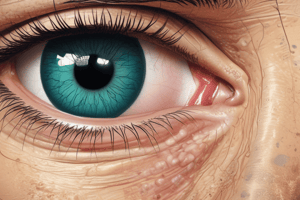Podcast
Questions and Answers
Define primary skin lesion and list three types.
Define primary skin lesion and list three types.
Primary lesions are lesions that are a different color than the color of the skin and/or lesions that are raised above the surface of the skin. Three types of primary skin lesions are bulla, macule, and papule.
Define a secondary skin lesion and list three types.
Define a secondary skin lesion and list three types.
Secondary skin lesions are characterized by piles of material on the skin surface, such as a crust or scab, or by depressions in the skin surface, such as an ulcer. Three types of secondary skin lesions are crust, excoriation, and fissure.
Name and describe at least five disorders of the sebaceous glands.
Name and describe at least five disorders of the sebaceous glands.
Milia are benign, keratin-filled cysts that appear just under the epidermis with no visible opening. Acne is characterized by chronic inflammation of the sebaceous glands from retained secretions and bacteria. A sebaceous cyst is a large, protruding pocket-like lesion filled with sebum. Seborrheic Dermatitis is characterized by redness, dry or oily scaling, and itchiness. Rosacea is a chronic condition appearing primarily on the cheeks and nose.
Name and describe at least five changes in skin pigmentation.
Name and describe at least five changes in skin pigmentation.
Name and describe the three forms of skin cancer.
Name and describe the three forms of skin cancer.
What are the two major causes of acne and how should they be effectively treated?
What are the two major causes of acne and how should they be effectively treated?
What is the most significant factor in skin aging and increasing the risk of types of skin cancer?
What is the most significant factor in skin aging and increasing the risk of types of skin cancer?
Explain the effect of overexposure to the sun on the skin.
Explain the effect of overexposure to the sun on the skin.
What is contact dermatitis and how can it be prevented?
What is contact dermatitis and how can it be prevented?
Study Notes
Primary Skin Lesions
- Primary lesions differ in color and/or are raised above the skin surface.
- Examples include bulla (large blisters), macule (flat discoloration), and papule (small raised bump).
Secondary Skin Lesions
- Secondary lesions consist of material on the skin surface or depressions in the skin.
- Examples include crust (dried exudate), excoriation (scratch marks), and fissure (cracks in the skin).
Disorders of the Sebaceous Glands
- Milia: Benign cysts filled with keratin, located just under the epidermis, without openings.
- Acne: Chronic inflammation of sebaceous glands due to retained secretions and bacteria.
- Sebaceous Cyst: Large protruding lesion filled with sebum.
- Seborrheic Dermatitis: Inflammation of sebaceous glands leading to redness and scaling.
- Rosacea: Chronic condition affecting cheeks and nose, often characterized by redness.
Changes in Skin Pigmentation
- Albinism: Congenital absence of melanin, resulting in hypopigmentation.
- Stain: Abnormal brown or wine-colored discoloration with irregular shape.
- Leukoderma: Skin condition that produces lighter patches.
- Lentigines: Commonly known as freckles, small yellowish-brown spots related to sun exposure.
- Nevus: Also known as a birthmark; a malformation due to abnormal pigmentation.
Forms of Skin Cancer
- Basal Cell Carcinoma: Most common skin cancer; presents as light or pearly nodules.
- Squamous Cell Carcinoma: More serious than basal cell, noted for scaly red papules or nodules.
- Malignant Melanoma: Most severe form; characterized by dark brown or black patches, often uneven.
Major Causes of Acne
- Heredity and hormonal changes are primary contributors.
- Treatment includes cleansing and exfoliating, while avoiding fatty and harsh skin care products.
Factors in Skin Aging and Cancer Risk
- Extrinsic factors are significant contributors to skin aging and increased cancer risk.
Effects of UV Overexposure
- Overexposure to UV rays weakens collagen and elastin fibers, accelerating skin aging.
Contact Dermatitis
- Inflammation resulting from exposure to irritating chemicals.
- Prevention includes wearing gloves and moisturizing hands regularly.
Studying That Suits You
Use AI to generate personalized quizzes and flashcards to suit your learning preferences.
Description
Test your knowledge with these flashcards focusing on primary and secondary skin lesions as discussed in Milady Chapter 8. This quiz covers definitions and examples such as bulla, macule, and papule, essential for understanding skin disorders and diseases.




